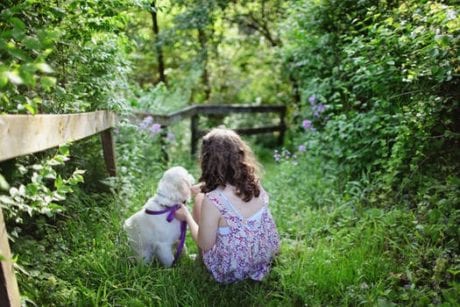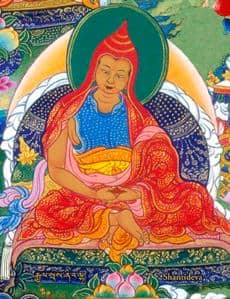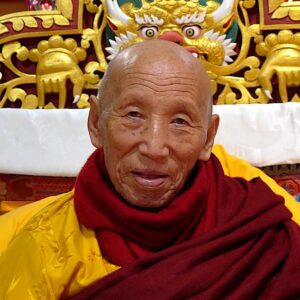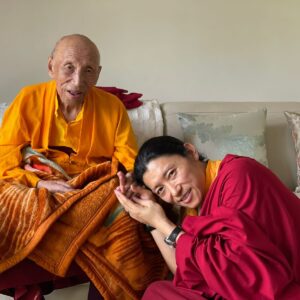As Buddhist practitioners, we begin by always bringing our practice to our own mind and our own level of experience–regardless of what practice we do. We want to see the integration of our practice and our daily life. And most importantly, we want to have a pure heart, pure motivation, and pure intention. In this video teaching, Phakchok Rinpoche discusses how we go about building the best motivation–that of bodhicitta.
Building Bodhicitta Beginning with Loving Kindness
 We begin slowly, by first making the wish to practice loving-kindness and compassion every day. This intention shifts our motivation to focus outwards–to loosen our fixation on our self. But, after some time, we should not just stop here–at wishing others to be happy–then we add the greater motivation to expand our motivation even wider to bodhicitta. Most importantly as we take this step, we want to see self and others as exactly equal–all sentient beings, even animals or small bacteria as the same.
We begin slowly, by first making the wish to practice loving-kindness and compassion every day. This intention shifts our motivation to focus outwards–to loosen our fixation on our self. But, after some time, we should not just stop here–at wishing others to be happy–then we add the greater motivation to expand our motivation even wider to bodhicitta. Most importantly as we take this step, we want to see self and others as exactly equal–all sentient beings, even animals or small bacteria as the same.
We see that there is no difference between human beings and tiny sentient life forms–each being wishes happiness and does not wish to suffer.
Building Bodhicitta–Respecting Others
If we take some time to reflect carefully, when we don’t see all beings the same as ourselves, we are being disrespectful. We show disrespect by not treating others as important. One of our objectives, to clean ourselves, is to really see and feel emotionally, mentally, and from the bottom of our heart–this feeling that we should respect all beings just as we respect ourselves.
That is the real beginning of the bodhisattva path. The only way to transform is to focus on ourselves and all other beings as equal–that’s a crucial step. Often for us, enlightenment is not relevant–we don’t see it as achievable. But, if we can start thinking seriously about bodhicitta, enlightenment becomes truly achievable.
We transform by beginning with ourselves–we reflect on our own mind, heart, and experience–and then we see how our bodhicitta develops through our practice.When we observe that change, we know that we are changing from the core.
See all beings like yourself. That means all sentient beings, but we help ourselves train by treating everything with respect. Rinpoche suggests we adopt a respectful attitude to everything we use or encounter, such as flowers or candles. Treat objects carefully and in a dignified way. Bodhicitta takes time. And you’ll see that as your view of all beings changes, you will naturally act respectfully and kindly even to inanimate items. You won’t throw things or break things, or treat objects so casually. After all, does it really help when we throw our phone because we’re frustrated?
Building Bodhicitta Reveals Our Hidden Ego
We all have a hidden ego–but most of the time we don’t see that we have this. So, we need to make our ego appear, and then challenge it–we want to remove ego from the root. The way to do that is by exchanging others and self.
We begin just as we do the practice of loving-kindness. When we practice loving-kindness, we always start with our parents, our close family, loved ones, and friends, right? Then, we gradually expand that to neutral people, to strangers. Finally, after some period of time, we are able to extend loving-kindness to our enemies–those we hate. And we can learn to do this because hatred is not our nature–hatred is simply anger–a habit of our ego. Loving-kindness and compassion is our true nature. The more clinging we have toward our own ego, the more sticky our hatred remains. But the moment we let go of that habit, we can see the hatred begin to disappear. Compassion is at our core because compassion is our true mind nature.
Building Bodhicitta: Reflecting Our Nature
Exchanging self and other sentient beings is a crucial step on the path. And we practice in the same way, by starting with our parents and dear ones, and then slowly expanding outwards. In our meditation practice, we may have already seen glimpses of the nature of the mind, and this means that we actually recognize our pure nature. Moreover, if we understand that our nature is pure, then we also know that all beings have that same pure nature.
When we’ve had this experience, even if we still have ego, it is less than before–we don’t hold onto anger and hatred. Because we know that beings that appear “bad” still have that goodness, that pure nature–we get less emotional. We can see that negativity we perceive in others is not their essence, so it is easier for us to give rise to compassion. Once you really see your own positive quality, your own true nature, then you stop hating yourself.
Building Bodhicitta: Advice from the Great Bodhisattvas

Great bodhisattvas such as Śāntideva (c.685-763) and Atiśa Dīpaṃkara Śrījñāna (980-1054) all mention that we need to practice exchanging self and other. We can benefit from reading the first chapter of Śāntideva’s Bodhicaryāvatāra: An Introduction to the Bodhisattva’s Way of Life to understand the tremendous qualities we develop by cultivating bodhicitta.
In Chapter Eight of the same text, Śāntideva explains in detail how to perform the exchange meditation. We see that this is a process; we begin with those we already love and cherish, and then gradually widen our circle. And we work with this repeatedly, by envisioning ourselves in different circumstances and positions as we relate to others.
Please remember that this process takes some time–but if we put in the effort, we will feel our own hearts opening!
Additional Resources
Continue your study and reflection with part two of Building Bodhicitta here.











Responses
[…] first part of this video teaching, Building Bodhicitta Part One can be accessed here. And you can learn more about the practice of tonglen […]